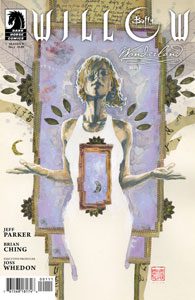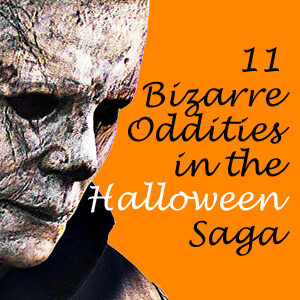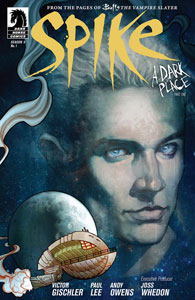When Spike and Willow duck out of the main “Buffy” Season 9 series, their solo adventures are told in a pair of five-issue miniseries, with Spike brooding over his purpose in life without Buffy, and Willow seeking a way to regain some of her magic powers.
“Spike: A Dark Place” (August 2012-January 2013)
IDW Comics had a pretty good formula going: Spike teams up with (and/or annoys) the Angel Investigations gang now and then, and when he isn’t with them, he’s with Team Spike in Las Vegas. Those stories provide nice character growth, as Spike branches out to leading his own team, similar to Angel taking that step when he moves from Sunnydale to Los Angeles.
Honestly, though, Spike is entertaining no matter what group he’s with, even if it’s a spaceship of intergalactic bugs – which is no joke, even though there’s an amusing undertone as the man-sized insects pick up human behavior and try to please their “Master Spike.” I’m probably not alone in saying Spike’s stories with the space bugs aren’t the vampire’s most entertaining side trips, although the bugs (introduced in the “Spike” standalone series and “Buffy” Season 8 around the same time) do have the important trait of linking the IDW comics with Spike’s return to Dark Horse.
Writer Victor Gischler’s first foray into the Buffyverse, “A Dark Place” is Spike’s final adventure with the bugs, taking place between his departure from “Buffy” Season 9 and emergence in “Angel & Faith” Season 9. He has gone off on his own for Buffy’s sake and chooses to begin his lost weekend by getting drunk on the dark side of the moon.
A succubus in a form-fitting jumpsuit named Morgan tries to draw Spike out of his funk, or perhaps she’s using him to get transportation to the Easter Island Hellmouth, which she hopes to open with a tiny shard of the Seed. I like the concept of the head statues having full bodies beneath the ground that climb out and attack Morgan and Spike.
It’s mildly interesting to see how Spike deals with the potentially shifty, potentially well-meaning Morgan, but ultimately she’s not among the most memorable women in Spike’s life. I would’ve preferred he visited his friends in Team Spike – which includes Beck and Tok, whose relationships with Spike had been left hanging — to get his mind off Buffy (to the degree that’s possible) rather than going on this adventure. “A Dark Place” is a smooth read – Gischler knows Spike’s character and speech rhythms – but it lacks the supporting cast to compare favorably to his IDW adventures.
3.5 stars

“Willow: Wonderland” (November 2012-March 2013)
As she did for one issue in Season 8 (“Willow: Goddesses and Monsters”), Willow steps aside from the main narrative of Season 9 to venture into other dimensions; here, her goal is to find some magic and bring it back to Earth. Written by Jeff Parker and “Angel & Faith” helmer Christos Gage, these five issues are a grand forest-trekking morality play in the style of “Alice in Wonderland.” The tale also calls to mind IDW’s “Fallen Angel: Reborn,” which chronicles Illyria’s similar quest for self-understanding.

The early issues also have a touch of “Normal Again” (“Buffy” 6.17), except that Willow’s alternate-reality escape isn’t in her head like it is for Buffy; it’s in another realm. She reunites with her green-skinned lover Aluwyn (from “Goddesses and Monsters”), whom she affectionately describes as a “lying, deceitful, sexy snake” in Issue 2. Aluwyn and her supercoven of witches offer to help Willow try to find magic and/or open a portal back to Earth, but living in this community is so pleasant Willow might choose to stay if she isn’t careful.
In a good Issue 4 twist, we learn that Willow’s monster companion Marrack – likewise seeking to return to Earth — is actually Rack, Willow’s magic “dealer” from the drug-addiction-metaphor episodes of “Buffy” Season 6. The similarity of the names makes a reader feel even dumber for not connecting the dots. “Wonderland” had already been a fable laden with fortune-cookie sayings up to this point, and the mumbo-jumbo really kicks in when Willow and Rack fight in the dimension where magic comes from. Artist Brian Ching draws a sort of heart and circulatory system floating in space.
The heart of magic informs Willow that “Rack brought you to the truth. There is no Dark Willow or Light Willow. No dark magic or light magic. Only dark intent and action.” Interestingly, this is the same interpretation of the Force put forward in Matthew Stover’s “Star Wars: The New Jedi Order – Traitor,” something that caused controversy among “Star Wars” Legends fans. Some wanted the Force to have literal, rather than metaphorical, light and dark sides. Luckily, in the Buffyverse, no one was set in their ways about light and dark magic. And besides, this interpretation is the satisfying one, because it gives Willow agency rather than making her the victim of an outside force.
So Willow heads back to San Francisco and the pages of “Buffy” Season 9, and as the only magical being on Earth, she realizes she wants to share magic rather than hoard it. She recognizes her inner nature as a good person. It wasn’t strictly necessary to use five full issues in other dimensions for Willow to reach this conclusion, but “Wonderland” is a decent exploration of where our favorite witch stands at this point in her life.
3.5 stars
Click here for an index of all of John’s “Buffy” and “Angel” reviews.

